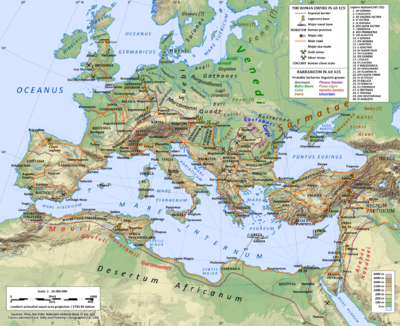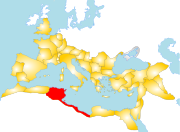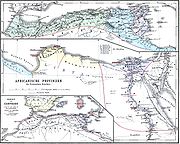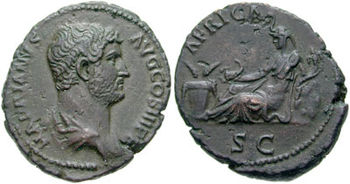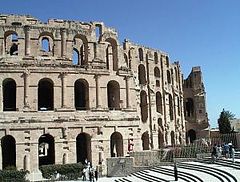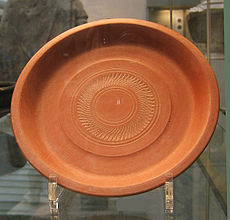
Africa (Roman province)
About this schools Wikipedia selection
SOS Children, which runs nearly 200 sos schools in the developing world, organised this selection. Child sponsorship helps children one by one http://www.sponsor-a-child.org.uk/.
The Roman province of Africa was established after the Romans defeated Carthage in the Third Punic War. It roughly comprised the territory of present-day northern Tunisia, north-eastern Algeria and the Mediterranean coast of modern-day western Libya along the Syrtis Minor. The Arabs later named roughly the same region as the original province Ifriqiya, a rendering of Africa.
History
The land acquired for the province of Africa was the site of the ancient city of Carthage. Other large cities in the region included Hadrumetum (modern Sousse, Tunisia), capital of Byzacena, Hippo Regius (modern Annaba, Algeria). The province was established by the Roman Republic in 146 BC, following the Third Punic War. Rome established its first African colony, Africa Proconsularis or Africa Vetus (Old Africa), governed by a proconsul, in the most fertile part of what was formerly Carthaginian territory. Utica was formed as the administrative capital. The remaining territory was left in the domain of the Numidian client king Massinissa. At this time, the Roman policy in Africa was simply to prevent another great power from rising on the far side of Sicily. In 118 BC, the Numidian prince Jugurtha attempted to reunify the smaller kingdoms. However, upon his death, much of Jugurtha's territory was placed in the control of the Mauretanian client king Bocchus; and, by that time, the romanization of Africa was firmly rooted. In 27 B.C, when the Republic had transformed into an Empire, the province of Africa began its Imperial occupation under Roman rule.
Several political and provincial reforms were implemented by Augustus and later by Caligula, but Claudius finalized the territorial divisions into official Roman provinces. Africa was a senatorial province. After Diocletian's administrative reforms, it was split into Africa Zeugitana (which retained the name Africa Proconsularis, as it was governed by a proconsul) in the north and Africa Byzacena in the south, both of which were part of the Dioecesis Africae. The region remained a part of the Roman Empire until the great Germanic migrations of the 5th century. The Vandals crossed into North Africa from Spain in 429 and overran the area by 439 and founded their own kingdom, including Sicily, Corsica, Sardinia and the Balearics. The Vandals controlled the country as a warrior-elite, enforcing a policy of strict separation and suppressing the local Romano-African population. They also persecuted the Catholic faithful, as the Vandals were adherents of the Arian heresy (the semi-trinitarian doctrines of Arius, a priest of Egypt). In 476, when the Roman Empire, had finally fallen, it became a remanent of the Empire. Towards the end of the 5th century, the Vandal state fell into decline, abandoning most of the interior territories to the Mauri and other Berber tribes of the desert.
In AD 533, Emperor Justinian, using a Vandal dynastic dispute as pretext, sent an army under the great general Belisarius to recover Africa. In a short campaign, Belisarius defeated the Vandals, entered Carthage in triumph and succeeded in reestablishing Roman rule over the province. The restored Roman administration was successful in fending off the attacks of the Amazigh desert tribes, and by means of an extensive fortification network managed to extend its rule once again to the interior. The North African provinces, together with the Roman possessions in Spain, were grouped into the Exarchate of Africa by Emperor Maurice. The exarchate prospered, and from it resulted the overthrow of the tyrannical emperor Phocas by Heraclius in 610. Its stability and strength in the beginning of the 7th century can be seen from the fact that Heraclius briefly considered moving the imperial capital from Constantinople to Carthage. Faced with the onslaught of the Muslim Conquest after 640, and despite occasional setbacks, the exarchate managed to stave off the threat, but in 698, a Muslim army from Egypt sacked Carthage and conquered the exarchate, ending Roman and Christian rule in North Africa. Thus the last of the provinces of the Western Roman Empire had ceased to exist, 222 years after the fall of Rome and the last Western Roman emperor.
Roman Africans
People from all over the Empire migrated into the Roman Africa Province, most importantly merchants, traders, and mainly veterans in early retirement who settled in Africa on farming plots promised for their military service. Historians like Theodore Mommsen estimated that under Hadrian nearly 1/3 of the eastern Numidia population (roughly modern Tunisia) was descended from Roman veterans.
A sizable Latin speaking population developed that was multinational in background, sharing the north African region with those speaking Punic and Berber languages. Imperial security forces began to be drawn from the local population, including the Berbers.
Abun-Nasr, in his A History of the Maghrib, said that "What made the Berbers accept the Roman way of life all the more readily was that the Romans, though a colonizing people who captured their lands by the might of their arms, did not display any racial exclusiveness and were remarkably tolerant of Berber religious cults, be they indigenous or borrowed from the Carthaginians. However, the Roman territory in Africa was unevenly penetrated by Roman culture. Pockets of non-Romanized Berbers continued to exist throughout the Roman period, even in such areas as eastern Tunisia and Numidia."
By the end of the Western Roman Empire nearly all of the Maghreb was fully romanized, according to Mommsen in his The Provinces of the Roman Empire and the Roman Africans enjoyed a high level of prosperity. This prosperity (and romanization) touched partially even the populations living outside the Roman limes (mainly the Garamantes and the Getuli), who were reached with Roman expeditions to Sub-Saharan Africa.
The willing acceptance of Roman citizenship by members of the ruling class in African cities produced such Roman Africans as the comic poet Terence, the rhetorician Fronto of Cirta, the jurist Salvius Julianus of Hadrumetum, the novelis Apuleius of Madauros, the emperor Septimius Severus of Lepcis Magna, the Christians Tertullian and Cyprian of Carthage, and Arnobius of Sicca and his pupil Lactantius; the angelic doctor Augustine of Thagaste, the epigrammatist Luxorius of Vandal Carthage, and perhaps the biographer Suetonius, and the poet Dracontius.
— Paul MacKendrick, The North African Stones Speak (1969), UNC Press, 2000, p.326
Economics
The prosperity of most towns depended on agriculture. Called the "granary of the empire", North Africa, according to one estimate, produced one million tons of cereals each year, one-quarter of which was exported. Additional crops included beans, figs, grapes, and other fruits. By the second century, olive oil rivalled cereals as an export item. In addition to the cultivation of slaves, and the capture and transporting of exotic wild animals, the principal production and exports included the textiles, marble, wine, timber, livestock, pottery such as African Red Slip, and wool.
The incorporation of colonial cities into the Roman Empire brought an unparalleled degree of urbanization to vast areas of territory, particularly in North Africa. This level of rapid urbanization had a structural impact on the town economy, and artisan production in Roman cities became closely tied to the agrarian spheres of production. As Rome's population grew, so did her demand for North African produce. This flourishing trade allowed the North African provinces to increase artisan production in rapidly developing cities, making them highly organized urban centers. Many Roman cities shared both consumer and producer model city aspects, as artisanal activity was directly related to the economic role cities played in long-distance trade networks. The urban population became increasingly engaged in the craft and service sectors and less in agrarian employment, until a significant portion of the town’s vitality came from the sale or trade of products through middlemen to markets in areas both rural and abroad. The changes that occurred in the infrastructure for agricultural processing, like olive oil and wine production, as trade continued to develop both cities and commerce directly influenced the volume of artisan production. The scale, quality, and demand for these products reached its acme in Roman North Africa.
Pottery production
The North African provinces spanned across regions rich with olive plantations and potters' clay sources, which led to the early development of fine Ancient Roman pottery, especially African Red Slip terra sigillata tableware and clay oil lamp manufacture, as a crucial industry. Lamps provided the most common form of illumination in Rome. They were used for public and private lighting, as votive offerings in temples, lighting at festivals, and as grave goods. As the craft developed and increased in quality and craftsmanship, the North African creations began to rival their Italian and Grecian models and eventually surpassed them in merit and in demand. The innovative use of molds around the 1st c. BC allowed for a much greater variety of shapes and decorative style, and the skill of the lamp maker was demonstrated by the quality of the decoration found typically on the flat top of the lamp, or discus, and the outer rim, or shoulder. The production process took several stages. The decorative motifs were created using small individual molds, and were then added as appliqué to a plain archetype of the lamp. The embellished lamp was then used to make two plaster half molds, one lower half and one upper half mold, and multiple copies were then able to be mass produced. Decorative motifs ranged according to the lamp's function and to popular taste. Ornate patterning of squares and circles were later added to the shoulder with a stylus, as well as palm trees, small fish, animals, and flower patterns. The discus was reserved for conventional scenes of gods, goddesses, mythological subjects, scenes from daily life, erotic scenes, and natural images. The strongly Christian identity of post-Roman society in North Africa is exemplified in the later instances of North African lamps, on which scenes of Christian images like saints, crosses, and biblical figures became commonly articulated topics. However, traditional mythological symbols had enduring popularity as well, which can be traced back to North Africa's Punic heritage. Many of the early North African lamps that have been excavated, especially those of high quality, have the name of the manufacturer inscribed on the base, which gives evidence for a highly competitive and thriving local market that developed early and continued to influence and bolster the colonial economy.
After a period of artisanal, political, and social decline in the 3rd c. AD, lamp-making revived and accelerated artistry in the early Christian age to new heights. The introduction of fine local red-fired clays in the late fourth century triggered this revival. African Red Slip ware (ARS), or African Terra Sigillata, revolutionized the pottery and lamp-making industry. ARS ware was produced from the last third of the 1st c. AD onwards, and was of major importance in the mid to late Roman periods. Famous in antiquity as "fine" or high-quality tableware, it was distributed both regionally and throughout the Mediterranean basin along well-established and heavily-trafficked trade routes. North Africa's economy flourished as its products were dispersed and demand for its products dramatically increased. Initially, the ARS lamp designs imitated the simple design of third to fourth century courseware lamps, often with globules on the shoulder or with fluted walls. But new, more ornate designs appeared before the early fifth century as demand spurred on the creative process. The development and widespread distribution of ARS finewares marks the most distinctive phase of North African pottery-making.
These characteristic pottery lamps were produced in large quantities by efficiently organized production centers with large-scale manufacturing abilities, and can be attributed to specific pottery-making centers in northern and central Tunisia by way of modern chemical analysis, which allows modern archeologists to trace distribution patterns among trade routes both regional and across the Mediterranean. Some major ARS centers in central Tunisia are Sidi Marzouk Tounsi, Henchir el-Guellal (Djilma), and Henchir es-Srira, all of which have ARS lamp artifacts attributed to them by the microscopic chemical makeup of the clay fabric as well as macroscopic style prevalent in that region. This underscores the idea that these local markets fueled the economy of not only the town itself, but the entire region and supported markets abroad. Certain vessel forms, fabrics, and decorative techniques like rouletting, appliqué, and stamped décor, are specific for a certain region and even for a certain pottery centre. If neither form nor decoration of the material to be classified is identifiable, it is possible to trace its origins, not just to a certain region but even to its place of production by comparing its chemical analysis to important northeastern and central Tunisian potteries with good representatives.
Known governors of Roman Africa
Republican era
Unless otherwise noted, names of governors in Africa and their dates are taken from T.R.S. Broughton, The Magistrates of the Roman Republic, (New York: American Philological Association, 1951, 1986), vol. 1, and vol. 2 (1952).
146–100 BC
Inscriptional evidence is less common for this period than for the Imperial era, and names of those who held a provincia are usually recorded by historians only during wartime or by the triumphal fasti. After the defeat of Carthage in 146 BC, no further assignments to Africa among the senior magistrates or promagistrates are recorded until the Jugurthine War (112–105 BC), when the command against Jugurtha in Numidia became a consular province.
- P. Cornelius Scipio Africanus Aemilianus (146 BC)
- L. Calpurnius Bestia (111 BC)
- Sp. Postumius Albinus (110–109 BC)
- Q. Caecilius Metellus Numidicus (109–107 BC)
- C. Marius (107–105 BC)
- L. Cornelius Sulla (105 BC)
90s–31 BC
During the civil wars of the 80s and 40s BC, legitimate governors are difficult to distinguish from purely military commands, as rival factions were vying for control of the province by means of force.
- None known with reasonable certainty for the 90s
- P. Sextilius (88–87 BC)
- Q. Caecilius Metellus Pius (86–84 BC)
- C. Fabius Hadrianus ( 84— 82 BC)
- Gn. Pompeius Magnus (82–79 BC)
- L. Licinius Lucullus (77–76/75 BC)
- A. Manlius Torquatus (69 BC or earlier)
- L. Sergius Catilina (67–66 BC)
- Q. Pompeius Rufus (62–60/59 BC)
- T. Vettius, cognomen possibly Sabinus (58–57 BC)
- Q. Valerius Orca ( 56 BC)
- P. Attius Varus (52 BC and probably earlier; see also below)
- C. Considius Longus (51–50 BC)
- L. Aelius Tubero (49 BC; may never have assumed the post)
- P. Attius Varus (seized control again in 49 and held Africa till 48)
- Q. Caecilius Metellus Pius Scipio Nasica (47 BC)
- M. Porcius Cato (jointly in 47 BC with special charge of Utica)
- C. Caninius Rebilus (46 BC)
- C. Calvisius Sabinus (45–early 44 BC, Africa Vetus)
- C. Sallustius Crispus, the historian usually known in English as Sallust (45 BC, Africa Nova)
- Q. Cornificius (44–42 BC, Africa Vetus)
- T. Sextius (44–40 BC, Africa Nova)
- C. Fuficius Fango (41 BC)
- T. Statilius Taurus (35 BC)
- L. Cornificius (34–32 BC)
Imperial era
Principate
Reign of Augustus
- Gaius Aelius Gallus (26-24 BC)
- Lucius Aelius Lamia
- Publius Quinctilius Varus approx (9/8-4 BC)
Reign of Tiberius
- Lucius Nonius Asprenas
- Marcus Furius Camillus ( 17– 19)
- Lucius Apronius ( 19– 21)
- Quintus Junius Blaesus ( 21– 23)
- Publius Cornelius Dolabella ( 23– 24)
Reign of Claudius
- Titus Statilius Taurus IV (51-53CE)
- Curtius Rufus
Later Empire
Governors are directly chosen by the Emperors, without Roman Senate approval.
- Iulianus, possibly Amnius Anicius Julianus (302 circa)
- Petronius Probianus (315-317)
- Aconius Catullinus (317-318)
- Fabius Aconius Catullinus Philomathius ( vicarius, 338-339)
- Anicius Probinus (396-397)
- Gabinius Barbarus Pompeianus (400-401)
- Aurelius Anicius Symmachus (415)

